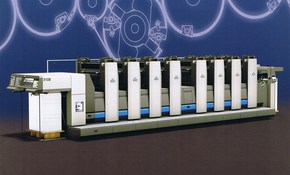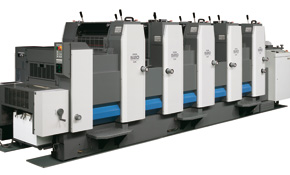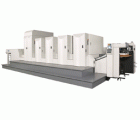The story of the Ryobi 3300 series starts back in the mid-1980s, when the 3302 was released. This two-colour press was modified until 1996, when the four-colour 3304H burst on to the scene. It came with continuous dampening, so it could maintain a stable aqua film on the plate. The dampener volume was controlled to match the ink, plate, paper and press conditions with a motor-driven fountain roller.
In 1998, Ryobi then went a step further, introducing the HA version of the press. The A on the machine stands for semi-automatic plate change. The minder positions the plate on the positioning pins, presses a button and the press does the rest. There’s also no need to bend the plate’s leading or tall edge.
It resulted in some “stunning” results, according to Peter Erskine, QLD state manager at local Ryobi dealer Cyber. The product was the first four-colour option in SRA3-sized portrait format.
“It uses a five-cylinder principle, with double-diameter impression cylinders. This meant there were just four gripper changes needed,” says Erskine.
Standard shape
The 3304 features a universal paper feed, 16-roller inker, six water rollers and a centralised oiling system. It uses Ryobi’s well-known ‘V’ shape configuration for its impression cylinders, printing units and double-diameter transfer drums. The result is fewer gripper changes between the first and final printing unit. It also means the machine has a compact footprint of 3.7x1m.
The machine far exceeded the expectations of its manufacturer. As an SRA3 four-colour machine, its target market was the production of short-run, low-cost, basic colour work, such as leaflets, flyers, envelopes and postcards.
“However, customers are stretching the machine’s abilities to produce quality reproductions, such as small posters. These applications are really intended for a B3 landscape press,” says Erskine.
Improvements have been made on the machine to keep it up-to-date with current technology, but these were mainly software upgrades, rather than hardware modifications.
“We also standardised the off-press controls, but the machine is essentially still the same,” says Erskine.
The 3304 has remote control ink ducts, ink temperature control, automatic dampening presetting, automatic blanket and cylinder wash-up. While optional extras included ink volume pre-setting.
“As with all used presses, check the cylinders for any damage, the roller condition and the ink ducts for consistent delivery,” advises Erskine. He adds that more than 10 presses have been sold in Australia and “thousands” worldwide. The 3304 is aimed at copy shops, stationary printers and smaller print shops. He adds that the bestselling Ryobi models locally are the 750 and 920 series, aimed at commercial and packaging printers.
While the H model of the 3304 is no longer in production, the 3304HA is still sold new. Both new and used presses can be sourced from Cyber directly. The dealer also takes in good-quality machines as part-exchange.
Cyber says a new machine starts at $280,000 depending on the spec, while a used machine costs around $150,000, depending on age and condition.
Comment below to have your say on this story.
If you have a news story or tip-off, get in touch at editorial@sprinter.com.au.
Sign up to the Sprinter newsletter



